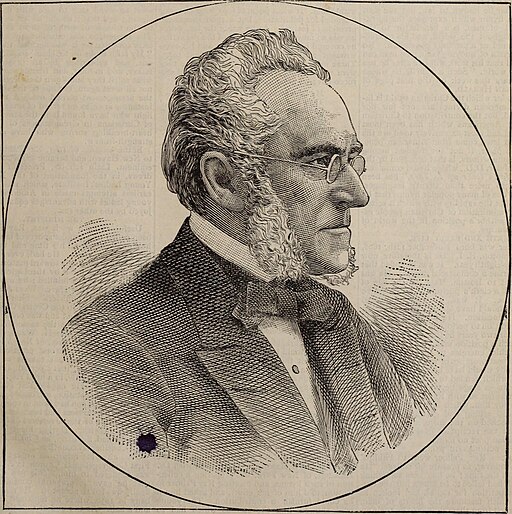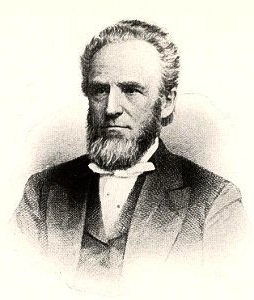Hymn History: My Faith Looks Up to Thee & Author: Ray Palmer
“He wrote the lines of verse as what he called his ‘Self-Consecration,’ simply putting down how he felt, ‘with a deep consciousness of my own needs, without the slightest thought of writing for another eye.’”
(Robert Cottrill)
The Origin of the Hymn “My Faith Looks Up to Thee”
Among the many hymns of the nineteenth century that have stood the test of time, “My Faith Looks Up to Thee” holds a special place in the hearts of Christians. With its prayerful tone and focus on personal trust in Christ, it has been a source of comfort in times of trial and a song of consecration in moments of dedication. Its story begins with a young seminary student who would later become one of America’s most influential pastors: Ray Palmer.
Ray Palmer: The Hymnwriter
Ray Palmer (1808–1887) was born in Little Compton, Rhode Island. From his youth, he was intellectually inclined and spiritually sensitive. He attended Phillips Academy in Andover, Massachusetts, and later Yale College, graduating in 1830. After Yale, Palmer taught at a girls’ school in New York City while also studying theology.
Palmer’s life as a young man was not without its struggles. He wrestled with feelings of inadequacy, spiritual longing, and the weight of life’s uncertainties. It was out of this context of inward searching that “My Faith Looks Up to Thee” was born.
Writing the Hymn
In 1830, shortly after graduating from Yale, Palmer penned the words to the hymn. At the time, he was only twenty-two years old. Unlike some hymns written for public occasions, Palmer’s hymn was originally a personal prayer. He later recalled that the words were written in his notebook one evening after a day of teaching.
Palmer described the experience as deeply spiritual and emotional:
“I wrote the stanzas with very tender emotion, and ended the last line with tears. I had no thought of writing for others, but simply gave expression to my own soul’s desire and faith.”
The text, which begins with the lines “My faith looks up to Thee, Thou Lamb of Calvary, Savior divine,” reflects a spirit of surrender, reliance, and consecration. It is essentially a prayer set to verse, asking for forgiveness, guidance, strength, and grace in life and death.
The Tune: Lowell Mason
The words of Palmer’s hymn might have remained a private devotion if not for a providential meeting with Lowell Mason (1792–1872), the pioneering American composer and music educator. Mason, already well established as a leader in church music, recognized the quality of Palmer’s text when he saw it in 1830.
Mason asked Palmer if he had any verses that could be set to music. Palmer handed him the lines of “My Faith Looks Up to Thee.” Mason was immediately struck by their beauty and spiritual depth. He composed a tune specifically for the text, naming it Olivet after the Mount of Olives in Jerusalem.
The union of Palmer’s heartfelt prayer and Mason’s gentle, flowing melody created one of the most enduring hymns of the century. The hymn was first published in 1831 in Spiritual Songs for Social Worship, a hymnal compiled by Mason and Thomas Hastings.
Reception and Spread
The hymn quickly gained popularity across the United States. Its tender language of faith and consecration spoke to the revival spirit of the time, when personal devotion and heartfelt religion were emphasized in American churches. Within a few decades, it had spread beyond America, appearing in hymnals in Britain and elsewhere.
Palmer himself was surprised by the wide reception of his hymn. Later in life he said:
“I could not be more astonished at its popularity than I am. It is not mine, but God’s.”
The hymn became associated not only with personal devotion but also with moments of national importance. It was often sung at funerals, prayer meetings, and times of mourning, becoming a song that carried believers through both private sorrow and public grief.
Theological Emphasis
The strength of “My Faith Looks Up to Thee” lies in its theological focus. It is not a hymn of triumph or victory, but one of humility, dependence, and trust. The believer acknowledges weakness and pleads for grace:
Faith and forgiveness: The hymn opens with faith directed toward Christ, the Lamb of Calvary.
- Consecration: The singer asks that his or her life be wholly devoted to God.
- Guidance and strength: It pleads for divine presence through life’s dark pathways.
- Hope in death: It looks to Christ for comfort and eternal joy beyond the grave.
This combination of faith, consecration, and hope explains why the hymn has resonated so widely across denominational lines.
Legacy
Ray Palmer went on to serve as a Congregational minister, spending much of his career in Albany, New York, and later in Newark, New Jersey. He wrote numerous hymns, but “My Faith Looks Up to Thee” remained his most famous contribution.
Lowell Mason, too, left an enduring legacy as a composer and educator, shaping the musical life of American churches for generations. The partnership of Palmer’s text and Mason’s tune created one of the finest examples of American hymnody.
Today, “My Faith Looks Up to Thee” continues to be sung in churches worldwide. Its prayerful tone makes it appropriate for services of commitment, times of sorrow, and moments of personal reflection. Like Palmer himself intended, it remains a simple yet profound expression of one soul’s reliance on Christ.
Conclusion
The origin of “My Faith Looks Up to Thee” reminds us that some of the most enduring hymns begin in moments of personal devotion. Ray Palmer, a young teacher with a heart full of longing and trust, penned words that spoke not only for himself but for countless believers across the generations. With Lowell Mason’s tune giving the text a musical home, the hymn became a timeless prayer of faith and consecration.
From its quiet beginnings in a notebook in 1830 to its place in hymnals around the world, the hymn continues to direct the eyes of Christians upward—to Christ, the Lamb of Calvary, the Savior divine.
Related
Sorry, no records were found. Please adjust your search criteria and try again.
Sorry, unable to load the Maps API.

